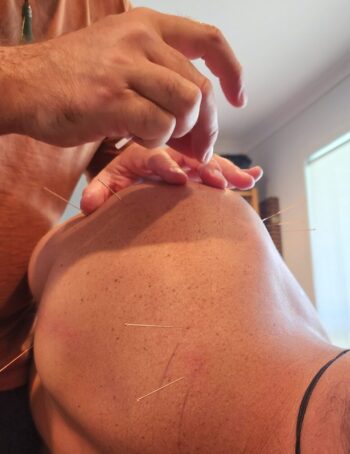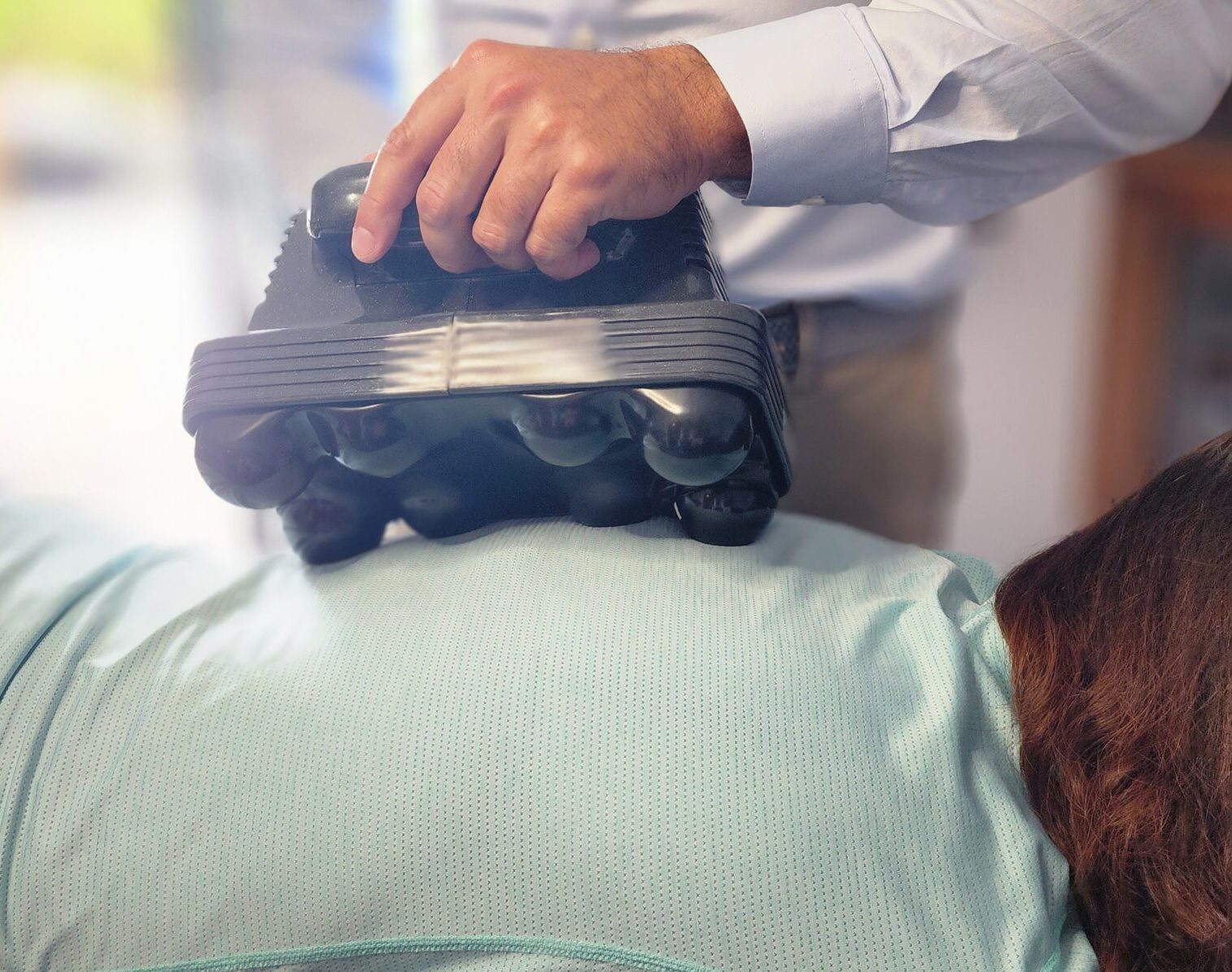Sport
Are you eager to optimize your body’s performance and proactively address or treat sport-related injuries? Consider incorporating Chiropractic care into your routine today!
In conjunction with Chiropractic joint adjustments, our comprehensive services may offer additional benefits to your body, including:

Dry Needling
Determining whether your injury is more joint-related or tissue-related can be complex, and the answer often lies in a combination of both factors. Enter Dry Needling—a highly effective solution for addressing persistent soft tissue injuries involving ligaments, tendons, fascia, and tight muscles. Our approach is to seamlessly integrate Chiropractic care with Dry Needling, strategically applied when necessary. This dual approach allows us to comprehensively address both joint and tissue issues simultaneously, enhancing the overall healing process for optimal outcomes.




Vibracussion Massage

Are you tired of dealing with persistent muscle tension? Discover the soothing benefits of Vibracussion massage instrumentation to help alleviate those stubborn knots. A gentle and rhythmic drumming action, powered by 8 oscillating discs, can effectively knead out tight tissue problem areas. Whether used before or after a Chiropractic adjustment, our patients rave about the relaxing sensation it provides. Experience the relief you deserve with our advanced Vibracussion technology.
Strapping
Therabands
FAQ
Is Dry Needling safe?
Rest assured, you’re in capable hands! Dry Needling, a safe and effective treatment option, has been skillfully applied by Dr. Will for numerous years, benefiting thousands of patients. Prioritizing hygiene and patient safety, any region designated for Dry Needling undergoes thorough sterilization with alcohol. The needles utilized are pre-packaged, strictly for one-time use, and promptly discarded into a medical waste bin. Your well-being is our top priority, maintaining the highest standards of cleanliness and safety throughout the process.
Is Dry Needling painful? Do the needles leave marks?
Fearful of needles? No need to worry! Unlike the painful memories of injections or blood draws, Dry Needles are remarkably thinner than standard syringe needles, helping to create a more comfortable experience for patients. Your comfort is our priority, and we strive to make the process as gentle and stress-free as possible. Say goodbye to needle anxiety and embrace a more relaxed and pain-free experience with Dry Needling.
In most cases, Dry Needling doesn’t leave noticeable marks on the body. The majority of individuals experience no visible signs after the procedure. However, it’s important to note that everyone’s response to Dry Needling can vary.
Occasionally, some individuals may experience minor redness or bruising at the needling sites. This is typically temporary and fades over a short period. Factors such as individual skin sensitivity, the specific technique used, and the nature of the treatment area can contribute to variations in the skin’s reaction.
Rest assured, Dr. Will will take measures to minimize any potential side effects and will provide guidance on post-treatment care. If you have specific concerns about potential marks or reactions, it’s always advisable to discuss them with Dr. Will before undergoing Dry Needling.
Anything I can do to help myself following Dry Needling?
Following Dry Needling, it’s common to experience positive changes in your overall well-being. Many patients report a sense of relief and improvement in their symptoms. Here are a few considerations for your post-Dry Needling experience:
1. Hydration: It’s essential to stay well-hydrated after Dry Needling. Adequate water intake can help flush out toxins and promote healing.
2. Mild Discomfort: Some individuals may experience mild soreness or discomfort in the treated areas. This is normal and often temporary. Applying ice or heat as recommended by your healthcare provider can help alleviate any post-treatment discomfort.
3. Physical Activity: While light activities are generally encouraged, it’s advisable to avoid intense workouts immediately after Dry Needling. Dr Will can guide you on when it’s appropriate to resume your regular exercise routine or advise rest.
4. Communication: Keep an open line of communication withDr. Will. Share any concerns or changes you notice in your symptoms so that adjustments can be made to your treatment plan if necessary.
How will I feel after Dry Needling?
After Dry Needling, many individuals report feeling great, experiencing pain relief, and improved overall well-being. However, it’s not uncommon to also feel a sensation of tiredness, fatigue, or mild achiness in the treated areas within the first 24 hours. This is a normal response and can be part of the body’s healing process.
It’s important to note that individual responses to Dry Needling can vary, and your experience may depend on factors such as the nature of your condition, the extent of the treatment, and your body’s unique response.
If you experience any discomfort, it’s generally mild and temporary. Applying ice or heat as recommended by your healthcare provider, staying well-hydrated, and getting adequate rest can contribute to a more comfortable recovery.
As always, communicate any concerns or unexpected symptoms with Dr. Will to help provide guidance based on your specific situation.
Anything I can do to help my body following Static or Dynamic strapping?
Following strapping, whether it’s static strapping for stabilization or dynamic strapping using kinesio tape for activity support, there are several self-care measures you can take to enhance the effectiveness of the strapping and ensure your comfort:
For Static Strapping:
Avoid Aggravating Movements: Be mindful of movements or activities that may aggravate the injured area. Minimize stress on the affected region to allow for proper healing.
Gentle Range of Motion Exercises: Perform gentle range of motion exercises, as recommended by your healthcare provider, to prevent stiffness and promote flexibility.
Follow Strapping Guidelines: Adhere to any specific guidelines provided by your healthcare professional regarding the duration and care of the static strapping.
For Dynamic Strapping (Kinesio Tape):
Skin Inspection: Regularly inspect the skin underneath the kinesio tape for any signs of irritation, redness, or discomfort.
Gentle Removal: When removing kinesio tape, do so gently to avoid unnecessary stress on the skin. Peel it off slowly, following the direction of hair growth.
Avoid Harsh Chemicals: Refrain from applying harsh chemicals, lotions, or oils on the skin under the tape, as they may affect adhesion.
Hypoallergenic Tape: If you experience skin reactions, such as irritation or allergies, inform Dr. Will who can apply hypoallergenic tape.
Any precautions during or after using a Theraband?
While using a Theraband can be beneficial for rehabilitation and exercise, it’s essential to take certain precautions to ensure a safe and effective experience. Here are some general precautions to be aware of during and following the use of a Theraband:
During Use:
1. Proper Form: Ensure that you are using the Theraband with the correct form and technique. Incorrect form can lead to ineffective workouts or potential injuries.
2. Appropriate Resistance: Begin with the appropriate resistance level for your fitness or rehabilitation level. Gradually progress to higher resistance levels as your strength improves.
3. Avoid Overstretching: Be cautious not to overstretch the Theraband, as it may lose elasticity and potentially snap, leading to injury. Use a band that provides enough resistance without excessive stretching.
4. Secure Anchoring: If anchoring the Theraband to an object, make sure it is secure and will not slip or release during use.
5. Smooth Movements: Perform exercises with controlled and smooth movements. Avoid jerky or sudden motions that can strain muscles or joints.
Following Use:
1. Check for Damage: Inspect the Theraband for any signs of wear, tear, or damage after each use. Replace it if you notice any issues to maintain its effectiveness and safety.
2. Hydration: Stay well-hydrated, especially if you’ve engaged in a workout using the Theraband.
3. Monitor for Discomfort: Pay attention to how your body feels after using the Theraband. If you experience unusual pain, discomfort, or persistent soreness, consult with a healthcare professional.
4. Rest and Recovery: Allow your muscles time to rest and recover between Theraband sessions. Overtraining can lead to fatigue and potential injuries.

